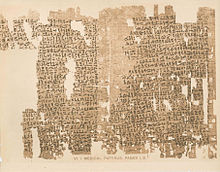Medical papyri from Lahun
In medical history, the medical papyri from Lahun are often referred to as Papyrus Kahun . The medical papyrus Kahun VI.1 and the veterinary papyrus Kahun LV.2 , both of ancient Egyptian origin, are combined, but nevertheless differentiated from one another in the professional world. They consist of smaller pieces of papyrus that are overloaded with various notes and appear to have been torn and thrown away after bills and everyday occurrences had been noted on them.
discovery
Both documents were discovered in 1888/89 by the English archaeologist William Flinders Petrie during excavations in the workers' settlement of Medinet-Kahun near El-Lahun (Lahun, Kahun) in the Fajum oasis , translated into English by Francis Llewellyn Griffith in 1898 and then the most important papyri were published . The papyri are now in the Petrie Museum of Egyptian Archeology at University College London .
Medicine papyrus Kahun VI.1
This papyrus, also called Kahun Medical Papyrus or Kahun Gynecological Papyrus , dates from around 1850 BC. ( Amenemhet III. , 12th Dynasty ) and primarily contains a kind of specialist book ( schesau ) on gynecology on a total of three pages with 17 diagnoses of women's diseases, 17 birth prognoses, recipes to enable conception, contraception or information on the treatment of hysterical ones Diseases. In addition, the papyrus contains lists of priests, temple inventories , various lists, a few literary texts including the hymn to King Sesostris III. and on the back a small statement from the time of Amenemhet III.
Veterinary Papyrus Kahun LV.2
This papyrus, also called the Veterinary Papyrus of Kahun , was made around 1800 BC. Dated ( Middle Kingdom ). In contrast to almost all other papyri, this text is not written in lines, but in columns , but only exists in fragments and contains remains of a book on animal diseases, which have not yet been fully translated. Nevertheless, an exact breakdown into several examination procedures can be seen, which correspond to the basic medical concept of brief diagnosis, description of symptoms and therapeutic instructions . The text sections on cattle diseases are best preserved, including the first surviving description of rinderpest . Fish, goose and dog are also named as patients.
meaning
With its veterinary content, this papyrus is the first and therefore oldest known veterinary literature document known to man. According to Driesch (1989), this important find also testifies to the high level of development of ancient Egyptian veterinary medicine.
More fragments
In addition to these two large fragments, there are also some smaller papyrus fragments from Lahun, which probably also belonged to medical papyri. However, they are so mutilated that little can be said about them.
See also
literature
- Marc Collier, Stephen Quirke: The UCL Lahun Papyri: Religious. Literary. Legal, Mathematical and Medical. London 2004, ISBN 1-84171-572-7 , pp. 54-69. (with boards and CD-Rom)
- Angela von den Driesch : History of veterinary medicine. 5000 years of veterinary medicine. Callwey, Munich 1989, ISBN 3-7667-0934-8 .
- Reinhard Froehner : The veterinary papyrus of Kahun. In: German veterinary weekly. 42, 1934, pp. 704-709.
- Francis Llewellyn Griffith: The Petrie Papyri. Hieratic Papyri from Kahun and Gurob. Text. London 1898, pp. 5-14.
- Francis Llewellyn Griffith: The Petrie Papyri. Hieratic Papyri from Kahun and Gurob. Plates. London 1898, Pl. 5-7.
- Wolfgang Kosack : An ancient Egyptian house book of veterinary medicine. In: Armant. 3, 1969, p. 172.
- Emmanuel Leclainche: Veterinary Medicine in Antiquity. in R. Toellner (Hrsg.): Illustrated history of medicine. volume 5. Andreas Verlagsbuchhandlung, Salzburg 1990, pp. 523-571.
- H. Neffgen: The veterinary papyrus of Kahun: a contribution to the history of veterinary medicine of the ancient Egyptians. Berlin 1904.
- Joris Peters, Angela von den Driesch: History of veterinary medicine. 5000 years of veterinary medicine. Schattauer, 2003, ISBN 3-7945-2169-2 .
Web links
- JM Stevens: Gynaecology from ancient Egypt: The papyrus Kahun: A translation of the oldest treatise on gynaecology that has survived from the ancient world. In: The Medical journal of Australia. Volume 2, Numbers 25-26, 1975 Dec 20-27, pp. 949-952, ISSN 0025-729X . PMID 768725 .
- Translation and pictures of VI.1
- Image from LV.2 from www.digitalegypt.ucl.ac.uk
- www.medizinische-papyri.de - Collection of medical papyri (private website)
Individual evidence
- ^ Petrie Museum, University College London 32057
- ^ Petrie Museum, University College London 32036
- ↑ a b Ägyptologie Marburg ( Memento from October 4, 2007 in the Internet Archive )
- ↑ Dissertation FU Berlin (pdf-file)
- ↑ Dissertation FU Berlin (pdf-file)
- ↑ FU Berlin (pdf-file)
- ↑ published by Collier / Quirke, op. Cit. Pp. 66-69


